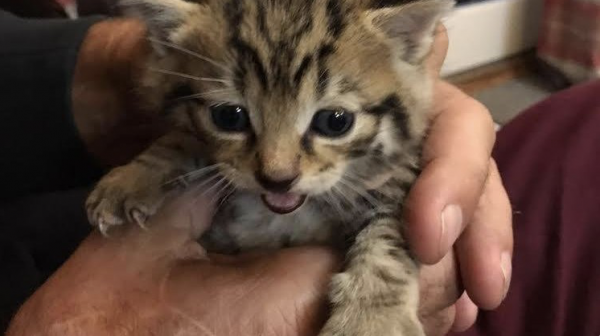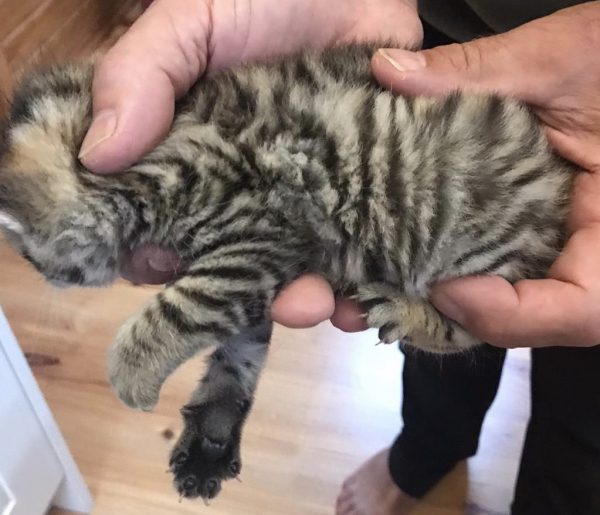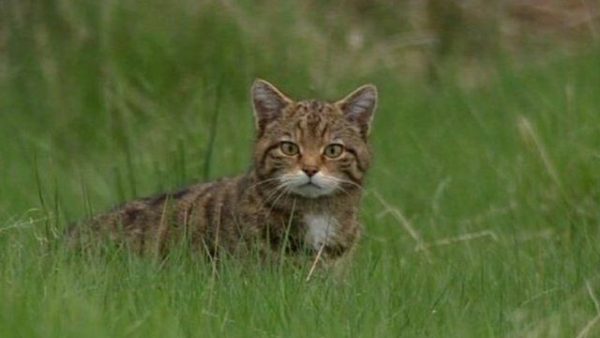
scottish wildcat kitten Saved
Wildcat Haven was contacted by a couple in the central Highlands of Scotland. The couple had rescued a weak, dehydrated and nearly hypothermic kitten during a recent bout of storms. They were almost certain this was not a domestic kitten. The Wildcat Haven team’s vast veterinary and wildlife rehabilitation experience knew to advise the couple to take the kitten to the nearest veterinarian as soon as possible. The couple agreed to take the kitten at once.
The veterinary clinic estimated the male kitten to only be about 4 weeks old. The kitten was treated and stabilized. Once the kitten was out of danger the clinic sent photos to Wildcat Haven
Wildcat Haven to the rescue
Wildcat Haven was astonished by the clear and striking wildcat markings. The body striping is clear, the dorsal stripe stops at the base of the tail, the tail is ringed and there are clear head stripes. Even though a cat will not be fully pelage (coat scored) until about 6 months of age, this rescued kitted is showing extremely strong wildcat signature markings.

Wildcat Kitten named Finlay
After assessing the kitten in person, Wildcat Haven was honored the couple wanted to place the cat in their care. The couple knew this was the cat’s best change of returning to the wild. The couple named the kitten Finlay, which means fair warrior in Gaelic. A fitting name indeed.
Finlay clearly passes the threshold in both appearance and behavior for being a wildcat. While everyone is thrilled to have saved this kitten, there is deep concern about what might have happened to his mother and siblings. A mother wildcat would never leave her 4 week old kittens, so they fear the worst.
This kitten had the potential to be a key player in the future survival of the Scottish wildcat and there is a debt of gratitude to the couple showing such compassion and care saving Finlay’s life.
Wildcat Haven will provide regular updates on Finlay’s progress. The Tiniest Tiger community supports Wildcat Haven. If you would like to adopt a Scottish wildcat for yourself or as a gift for someone pounce here. Adopt a Scottish Wildcat.
about scottish wildcats

The Scottish wildcat evolved from a population of European wildcats which became isolated by the English Channel over 9000 years ago. They are the largest of the wildcat family and can be double the size of a domestic pet cat and infinitely more ferocious.
The fur of the Scottish wildcat is a great deal thicker than that of a domestic cat. It displays very distinctive solid black and brown stripes. Spots, broken stripes or white fur are all indications of hybridization (cross-mating) with domestic cats.
Another notable feature is their thick banded tail, perfectly ringed with no dorsal stripe running off of the spine. Imperfect rings or dorsal markings are further signs of hybridisation.
Like all cats they have superb hearing, retractable claws, exceptional night vision and a powerful body conducive to sprinting and pouncing.
Scottish wildcats epitomize the solitary, independent super-predator and the mysterious and wild spirit of the Highlands in a way that no other animal can.